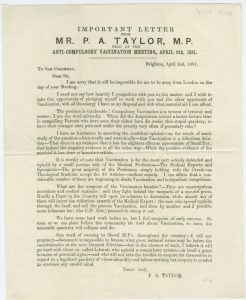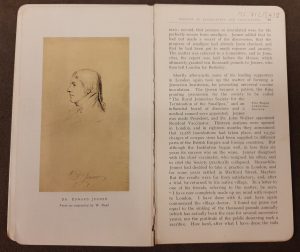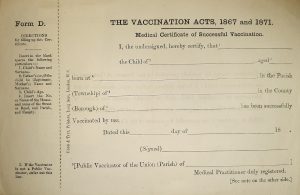January 27, 2021, by Kathryn Steenson
Vaccinations
Vaccines. They’ve been headline news for weeks, and earlier this month the Covid 19 Vaccination Centre at KMC opened its doors. Vaccination was explicitly legalised and made free of charge in the UK in 1840. At the time, smallpox, which had killed, disfigured and disabled people since antiquity, was the only disease that could be prevented in this way.
Edward Jenner is widely lauded as a pioneer for his smallpox vaccine in 1796, often overshadowing the smaller but still significant achievements of others, such as Thomas Dimsdale (1712-1800). Dimsdale was a doctor who popularised the prevention of smallpox by variolation in Europe (it had been widely practiced in Asia for centuries). This now-obsolete practice took infectious material (scabs, pus) from smallpox patients and scraped it into the skin of another person to cause a mild form of the disease that gave protection against more virulent strains. This earned him fame, and fortune followed in 1762 when Empress Catherine the Great of Russia invited him to St Petersburg to inoculate her, her son the Grand Duke Paul, and over 140 members of the Russian Court.
This is Dimsdale’s signature from a letter to Dorothy, Duchess of Portland which sadly makes no reference to smallpox or his exploits in Russia; instead he’s giving advice about the more traditional remedy of purging the bowels (specifically, the Duke’s).

Letter from Dr Dimsdale to the Duchess of Portland that once accompanied some purgative powders (no longer present). (Ref: Pw G 132)
Variolation was a huge step forwards and undoubtedly saved many lives, but it was still risky and about 1 in 50 patients died. This was still far safer than contracting smallpox, which killed about 1 in 5 patients, but to deliberately infect yourself with even mild smallpox required a level of bravery many of us would balk at today. Vaccination, which uses a weakened or killed form of a disease to cause an immune response, is much safer.
Edward Jenner (1749-1823) was a Gloucestershire physician and zoologist. At the time many in rural communities knew that people who caught cowpox did not catch smallpox. Most often it was milkmaids and farmers who caught cowpox, from the blisters on the udders of dairy cows. Similar blisters erupted on the hands and forearms where they had become infected, and they felt ill and feverish, but within a few weeks they recovered Jenner wasn’t the first to realise this cross-immunity, nor the first to use cowpox to immunise against smallpox, but he was the first to realise and publish that cowpox pus could protect other people from smallpox. This he tested by deliberately infecting people around him with cowpox and smallpox, in an experiment that would absolutely not get ethical approval today.
This is a page from a pamphlet entitled ‘History of Inoculation and Vaccination’ published in 1913. For reasons known only to the vandal responsible, it wasn’t the whole pamphlet that was kept, but a selection of pages torn from it. Several similar publications about the history of medicine were also mutilated at some point prior to 1967 by having images ripped out in a similar fashion (if you’d like to see portraits of distinguished medical men unencumbered by words, then they’re available in the Reading Room as MS 712).
Vaccination was immediately recognised as a major break though. Any opposition generally involved scepticism of using a bovine disease to prevent human disease, and in practice these original vaccine sceptics chose variolation over nothing at all, at least until it was outlawed in 1840. In 1853 vaccination became compulsory for all babies, despite considerable hostility. Vaccination certificates, like the one below, were issued by the medical professional giving the vaccination and sent a copy to the local registrar of births. Parents or guardians who failed to have their babies vaccinated by three or four months risked being convicted and fined.
Although surveys show that an overwhelming majority of adults in the UK would accept the vaccine if offered it, a minority have always promoted anti-vax nonsense. In this letter, Peter Alfred Taylor, the MP for Leicester, decried Smallpox vaccination as a ‘ridiculous delusion’ and a ‘miserable quackery’. He wrote this letter in 1881 and was confident that the ‘vaccination fanatics’ would be defeated. In fact it was smallpox that was defeated, 99 years later, by the very method he campaigned against.

Printed letter from Mr P. A. Taylor MP concerning the anti-compulsory vaccination meeting, 2 Apr 1881.
There was an enormous gap between the first ever vaccine in 1796 and the second ever vaccine, which was to prevent cholera and was developed by Louis Pasteur in 1880. After that progress accelerated, and rabies, tetanus and typhoid fever vaccines followed in relatively quick succession, and has continued at a rate of two or three new vaccines for diseases that infect human per decade.
The material featured in this blog post is held at Manuscripts & Special Collections, on King’s Meadow Campus. Due to the pandemic we have restricted opening procedures, but staff and students of the University of Nottingham are able to book appointments to come and view the archives and rare books. One day we will also be able to welcome back the public, but until then we are still able to answer enquiries and provide copies if you can’t get to the Reading Room in person.
No comments yet, fill out a comment to be the first




Leave a Reply